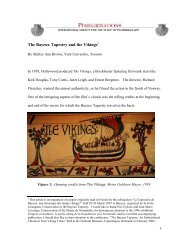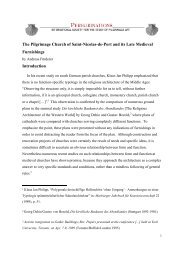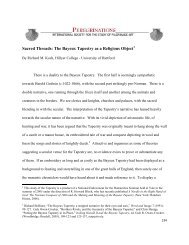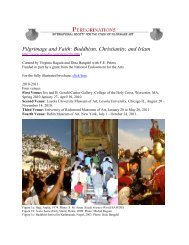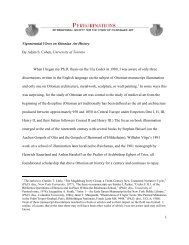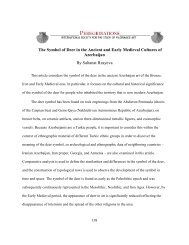Review of Michael Viktor Schwarz's, Visuelle ... - Peregrinations
Review of Michael Viktor Schwarz's, Visuelle ... - Peregrinations
Review of Michael Viktor Schwarz's, Visuelle ... - Peregrinations
You also want an ePaper? Increase the reach of your titles
YUMPU automatically turns print PDFs into web optimized ePapers that Google loves.
<strong>Review</strong> <strong>of</strong> <strong>Michael</strong> <strong>Viktor</strong> Schwarz’s, <strong>Visuelle</strong> Medien im christlichen Kult.<br />
Fallstudien aus dem 13. bis 16. Jahrhundert, Böhlau (Wien / Köln / Weimar 2002).<br />
By Viola Belghaus,<br />
TU Dresden / EPHE Paris<br />
Even more than the ongoing debate regarding the German education system,<br />
books like this serve as a gauge for the difficulties <strong>of</strong> the state-financed university<br />
system. In times <strong>of</strong> shrinking budgets, resulting in crisis <strong>of</strong> justification and intensified<br />
struggles between the different subjects, art history is also seeking its new<br />
methodological position within the humanities. The only way out <strong>of</strong> this dilemma seems<br />
to depend on their adaptability to the, in public discourse strongly present, keywords <strong>of</strong><br />
information and communication and their medial and technological innovations. For that<br />
reason, a field like media studies (Medienwissenschaft) has achieved a principal position<br />
within the university subjects, conveying its paradigm <strong>of</strong> media into nearly all other fields<br />
<strong>of</strong> research.<br />
With nothing less than a “medial turn,” <strong>Michael</strong> <strong>Viktor</strong> Schwarz announces his<br />
new book. It assembles independent case studies <strong>of</strong> well known and most widely<br />
discussed examples <strong>of</strong> western art history, combined under the common focus <strong>of</strong> their<br />
mediality. The central point is focused on the specific relationship <strong>of</strong> image and reality,<br />
describing and defining the different levels <strong>of</strong> their representation <strong>of</strong> reality thereby<br />
achieving virtual reality, restricted representation or symbolic references. The functional<br />
role <strong>of</strong> the images as media within the process <strong>of</strong> communication Schwarz describes<br />
particularly with reference to their material character including their functions, context,<br />
stylistic devices and their artistic character. He adamantly refuses the notion <strong>of</strong><br />
transforming art history into a history <strong>of</strong> images (Bildwissenschaft), where, in his<br />
opinion, the specific shape <strong>of</strong> the works <strong>of</strong> art are neglected.<br />
Figure 1. Mourning Virgin from Naumburg<br />
Screen, Naumburg Cathedral, 1245-60.<br />
Photo: H.J.B. Stanley<br />
Figure 2. Halberstadt Crucifix,<br />
Romanesque Period. Photo: Arnold<br />
Pettigrew.
With his first example, the author focuses the highly-problematic and <strong>of</strong>tendebated<br />
question <strong>of</strong> the function and role <strong>of</strong> images in medieval society. With its<br />
exceptional rood screen and the remarkable donor sculptures, the celebrated western<br />
choir in Naumburg has inspired many descriptions <strong>of</strong> different characters and from<br />
different origins. Out <strong>of</strong> this reception (which always emphasized the stupendous realism<br />
<strong>of</strong> the sculptures) Schwarz develops the concept <strong>of</strong> their immediate appearance<br />
(Unmittelbarkeit), which forms the leitmotif <strong>of</strong> his analysis. Therefore the author<br />
understands the presence <strong>of</strong> the represented figures, especially <strong>of</strong> the crucified Christ at<br />
the screen portal, as part <strong>of</strong> their medial effect resulting from a specific contract <strong>of</strong><br />
perception (Wahrnehmungsvertrag). Rather than generating the distance between image<br />
and observer, it simulates within its immediate appearance the virtual reality <strong>of</strong> epiphany.<br />
Schwarz clarifies this tension between presence and representation by referring to the<br />
generic conceptions <strong>of</strong> rood screens and rood crosses. Compared with the function <strong>of</strong> the<br />
architectural type <strong>of</strong> rood screens, the juxtaposition with the eastern choir in Naumburg<br />
very clearly demonstrates the different conception <strong>of</strong> the Naumburg screen. The eastern<br />
choir with the ensemble <strong>of</strong> rood screen, altar and the now-lost rood cross on the one hand<br />
encloses the choir as a clerical space, defining on the other hand a place for laity and their<br />
liturgical setting. The screen <strong>of</strong> the western choir, however, functions less as a border and<br />
more as a threshold and portal. (fig. 1) Moreover, one can observe some significant<br />
distinctions to traditional types <strong>of</strong> rood crosses. Compared with the rood cross <strong>of</strong><br />
Halberstadt, (fig. 2) Schwarz strengthens the independence <strong>of</strong> the solution at Naumburg,<br />
where the Crucifixion is placed within the portal rather than above the screen, achieving<br />
its liturgical presence by abstaining from all symbolic and allegoric systems <strong>of</strong> references<br />
still used in Halberstadt. In this context Schwarz refers to the anthropological theory <strong>of</strong><br />
liminality 1 describing how cultic communities during their ritual encounter with God are<br />
able to overcome the limitations <strong>of</strong> time and space within transitory moments. The<br />
immediate appearance <strong>of</strong> the crucified God prepares, while passing the threshold into the<br />
other sacral space <strong>of</strong> the Naumburg choir, an intensified liturgical experience that<br />
includes Christ’s epiphany during the Eucharistic ritual. Whereas the Halberstadt Cross,<br />
with its symbolic references, clearly demonstrates its status as an image and therefore<br />
enables a didactic usage, the Naumburg Cross indicates the tension between didactic and<br />
evident qualities <strong>of</strong> the medieval imagery. Consequently Schwarz explains the different<br />
conception <strong>of</strong> the Naumburg sculpture explicitly, not in stylistic terms (as transition from<br />
Romanesque to Gothic) or with new forms <strong>of</strong> piety (the practice <strong>of</strong> compassio), but rather<br />
as a media discourse reflecting the function and the power <strong>of</strong> images. Even though in<br />
theological discussion the function <strong>of</strong> imagery is strictly limited on didactic purposes,<br />
Schwarz focuses a clerical use <strong>of</strong> images. Numerous narratives <strong>of</strong> miraculous images and<br />
affective approaches to religious imagery document an elitist image discourse, where<br />
overcoming the strict borders <strong>of</strong> image and prototype was absolutely allowed and desired.<br />
Even though Schwarz’s analysis provides an appropriate description <strong>of</strong> the specific<br />
quality <strong>of</strong> representation, the still striking fact remains, why would a medium <strong>of</strong> this<br />
elitist discourse been placed towards the nave <strong>of</strong> Naumburg cathedral – a place always<br />
accessible for the laity?<br />
1 T.L. Carson, Liminal Reality and Transformational Power (Lanham, Maryland 1997), 85-88.
Figure 3. Detail <strong>of</strong> Parement de Narbonne, 1375-80, Louvre. Photo: C.M.<br />
Radcliffe.<br />
This question is pursued during the following chapters, reflecting once again the<br />
mode <strong>of</strong> representation within liturgical furnishings, focusing an illusionistic fresco in<br />
Assisi and the Parement de Narbonne. (fig. 3) Schwarz characterizes the representation<br />
<strong>of</strong> a sedilia in San Francesco as part <strong>of</strong> an illusionist liturgical furnishing demanding<br />
commemoration and liturgy by the visitors and the clerics <strong>of</strong> the church. The illusionistic<br />
character once again, with its exact description <strong>of</strong> details and impressions <strong>of</strong> improvised<br />
elements, suggests that the painting belongs to the real space <strong>of</strong> the church, therefore<br />
providing a discourse which explains different degrees <strong>of</strong> reality and levels <strong>of</strong> unreality.<br />
Confronting the beholder, for example, with the actual appearance <strong>of</strong> the heavenly figures<br />
within the altarpiece <strong>of</strong> the chapel, the former experience with the illusionistic sedilia<br />
enables the beholder to identify the artistic character <strong>of</strong> that illusion – thereby rebinding<br />
the presentation into its context <strong>of</strong> picturality. In this case, the realism serves not as a<br />
trigger or an increase in the quality <strong>of</strong> immediate appearance, on the contrary, it refers to<br />
the difference <strong>of</strong> image and prototype. A similar phenomenon, Schwarz presents, can be<br />
seen in the Parement de Narbonne, with its grisaille painting fitting into the practice <strong>of</strong><br />
medieval Lenten observance 2 on one hand, and on the other hand reflecting a<br />
phenomenon which Rudolf Preimesberger’s has described as a self-referential discourse<br />
<strong>of</strong> art. 3 The striking contrast <strong>of</strong> colorlessness and artistic character questions, according to<br />
Schwarz, the relation <strong>of</strong> cultic use and artful fashioning. The Parement’s function as a<br />
covering for an altarpiece during Lenten observance as its principal role does not supply a<br />
substitute for imagery, but rather removes the existing imagery out <strong>of</strong> sight. Thus<br />
Schwarz understands the mode <strong>of</strong> representation as a functional and media specific<br />
decision in which the representation <strong>of</strong> an image defuses the visual presence <strong>of</strong> the<br />
image. The role <strong>of</strong> grisaille painting is therefore not to be described as a simulation <strong>of</strong> art,<br />
2<br />
M. Teasdale Smith, “The Use <strong>of</strong> Grisaille as a Lenten Observance,“ Marsyas. Studies in the History <strong>of</strong><br />
Art, VIII, 1957-59, 43-54.<br />
3<br />
R. Preimesberger, “Zu Jan van Eycks Diptychon der Sammlung Thyssen-Bornemisza“, Zeitschrift für<br />
Kunstgeschichte LIV 1991, 459-489.
like Preimesberger understood its purpose, but rather as a representation <strong>of</strong> an absence or<br />
temporal invisible image.<br />
Figure 4. Tomb <strong>of</strong> Archbishop Henry Chichele, Canterbury Cathedral, 1424-26.<br />
Photo: Sarah Blick.<br />
While Schwarz hitherto focused almost solely on pictorial media describing even<br />
sculpture as images, within the following chapter he questions one <strong>of</strong> the principal issues<br />
<strong>of</strong> medieval images expounding the problem <strong>of</strong> body, image, and embodiment within<br />
tomb sculpture. The archbishop’s Henry Chichele tomb in Canterbury Cathedral is a<br />
well-known example used to apply Ernst Kantorowicz’s influential theory <strong>of</strong> the king’s<br />
two bodies. 4 (fig. 4) Seldom contradicted and further developed during recent years,<br />
Schwarz once again puts the predominate implications <strong>of</strong> a double portrayal as<br />
representation <strong>of</strong>, on the one hand, <strong>of</strong>ficial and on the other hand, individual, body under<br />
discussion. He doubts a visual implementation <strong>of</strong> the theory <strong>of</strong> the two bodies within the<br />
so-called double-decker tombs concerning the tradition <strong>of</strong> medieval tomb sculpture.<br />
Nonetheless, it remains an indisputable fact that the Gisant forms the traditional type <strong>of</strong><br />
tomb sculpture, whereas the Transi represents a younger invention, not able to establish a<br />
former tradition and thus remaining as an exceptional case. Assuming that the individual<br />
(Transi) is enlarged by the <strong>of</strong>ficial body (Gisant) and in a strict sense yet to be<br />
completed, seems to be a highly-problematic and vague thesis without any evidence<br />
found in written or material records. Rather than emerging from political theology,<br />
Schwarz proposes that the practice <strong>of</strong> funeral liturgy explains the typical difference <strong>of</strong> the<br />
transient corpse and the tomb image used to present <strong>of</strong>ficial dignity. With reference to<br />
perpetuated funeral lay out (Tomb <strong>of</strong> Henry II <strong>of</strong> England in Fontevrault Abbey) and to<br />
the usage <strong>of</strong> effigies (during the funeral ceremony <strong>of</strong> English and French kingship),<br />
Schwarz indicates the Transi models defined their function most <strong>of</strong> all as the corpse’s<br />
liturgical deputies. Some illuminations from manuscripts containing poetics <strong>of</strong> death and<br />
lamentation prove the idea <strong>of</strong> a present corpse during requiem and other liturgical funeral<br />
practices. Moreover, these illuminations likewise illustrate different modes <strong>of</strong><br />
representation – the reality <strong>of</strong> the decomposed corpse and the conventionality <strong>of</strong> the tomb<br />
image – strengthened by inscriptions where a fictional speaker addresses the audience,<br />
thereby suggesting a real presence. Hence the different modes <strong>of</strong> representation should<br />
4 Ernst H. Kantorowicz, The King’s Two Bodies. A Study in Medieval Political Theology, Princeton 1957.
not be described as a comparison <strong>of</strong> the <strong>of</strong>ficial and individual body, but rather as<br />
representation <strong>of</strong> a present corpse juxtaposed with a commemorative image illustrating<br />
the former presence <strong>of</strong> a living. The Gisant portrays that which is entirely past, while the<br />
appearance <strong>of</strong> the Transi illustrates eternal presence and truth.<br />
In the two final chapters, using Raphael’s Sistine Virgin and the self portrait <strong>of</strong><br />
Anton Pilgram in Vienna Cathedral, Schwarz works out some specific problems <strong>of</strong> early<br />
modern image culture. First, he describes recent research on the famous Virgin as part <strong>of</strong><br />
the liturgical furnishing <strong>of</strong> San Sisto in Piacenza. 5 Outlining the calculated strategy <strong>of</strong><br />
glances and gestures applied to the altar with the presented host and the rood cross, he<br />
emphasizes its implied references to Christian doctrine and their visual and substantial<br />
manifestations. The image’s specific shape Schwarz considers, in a second step, as<br />
rivalry between the visual appearance <strong>of</strong> the image and the substantial presence <strong>of</strong> the<br />
host, therefore contributing a reflection on the ability <strong>of</strong> painting to visualize the<br />
invisible. Thus approaching the positions <strong>of</strong> early modern art theory, he relativizes, with<br />
his last example, the largely-discussed commonplace <strong>of</strong> the development <strong>of</strong> the<br />
individual during Renaissance art and theory. The self portrait <strong>of</strong> the artist Anton Pilgram<br />
serves less as a pro<strong>of</strong> for individualization, than as an example <strong>of</strong> a strong typology <strong>of</strong><br />
portraiture which stages the artist’s piety and places his self into the church community.<br />
Even though Schwarz analysis without exception contains new and revealing<br />
insights and provides stimulating questions, he does not actually describe the mediality <strong>of</strong><br />
the image. That different forms <strong>of</strong> picturality are linked with different forms <strong>of</strong> liturgical<br />
usage remains a rather old and well-known fact and is, as a result <strong>of</strong> a new<br />
methodological approach, not weighty enough. In addition, some <strong>of</strong> his major terms are<br />
used in a highly variable manner. For example, the function <strong>of</strong> realism is described in one<br />
case as being used to overcome the difference <strong>of</strong> image and prototype (Naumburg) and in<br />
another case to reinforce the same difference (Assisi). From the viewpoint <strong>of</strong> the<br />
demanded medial history <strong>of</strong> images this arbitrariness <strong>of</strong> definition is critical. Moreover,<br />
the author, by defining his central term <strong>of</strong> mediality explicitly as a term <strong>of</strong> form and not<br />
<strong>of</strong> function, excludes central issues <strong>of</strong> a medial-orientated art history the reader would<br />
expect. One wonders, why Schwarz is obviously not interested in the form and function<br />
<strong>of</strong> prints – a new technology always linked with the media revolution – why he seems to<br />
lack any interest in the relationship <strong>of</strong> text and image, etc. Furthermore, his metaphorical<br />
writing is highly problematic – particularly in case <strong>of</strong> a foundation <strong>of</strong> a new<br />
methodological approach, a more precise terminology would have been desirable.<br />
Despite this criticism, the author displays an instructive and stimulating history on<br />
the various roles <strong>of</strong> images in religious cults, including the material and formal shape <strong>of</strong><br />
his analyzed examples, with more consequence than many other art historians.<br />
Nevertheless a medial history <strong>of</strong> art has to be written elsewhere.<br />
5 P. Ceschi Lavagetto, “L’immensa dolcezza e grandissima utilià. Il coro di San Sisto a Piacenza,“ Bologna<br />
1989; A. Prater, “Jenseits und diesseits des Vorhanges. Bemerkungen zu Raffaels sixtinischer Madonna als<br />
religiöses Kunstwerk,“ in: Münchner Jahrbuch der bildenden Kunst XL, 1991, 117-136.



